MGBBT0UBN: Business Organisations and Environments Essay
VerifiedAdded on 2023/06/10
|8
|2190
|443
Essay
AI Summary
This essay provides a comprehensive overview of business organizations and their environments, focusing on key concepts such as business types (sole trader, partnership, public limited company), organizational structures (tall and flat), and business functions (marketing, human resource management, operations). The essay uses InterContinental Hotels Group as a case study to illustrate these concepts, examining its organizational culture and the impact of functional management activities. It concludes by emphasizing the importance of effective organizational structure and culture in achieving business goals and fostering a positive work environment. The essay also references various academic sources to support its arguments.
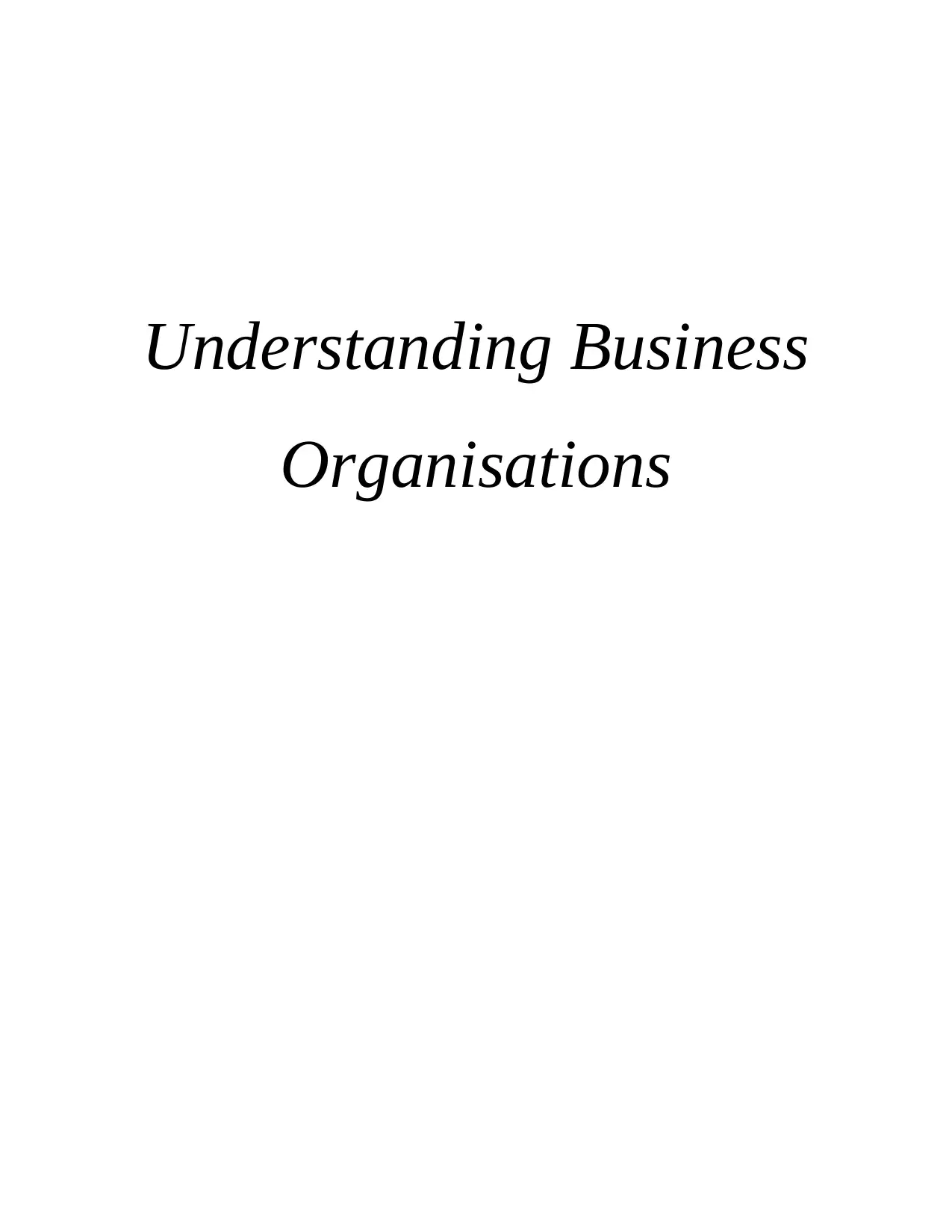
Understanding Business
Organisations
Organisations
Paraphrase This Document
Need a fresh take? Get an instant paraphrase of this document with our AI Paraphraser

Contents
Contents...........................................................................................................................................2
INTRODUCTION...........................................................................................................................1
MAIN BODY..................................................................................................................................1
CONCLUSION................................................................................................................................4
REFERENCES................................................................................................................................5
Contents...........................................................................................................................................2
INTRODUCTION...........................................................................................................................1
MAIN BODY..................................................................................................................................1
CONCLUSION................................................................................................................................4
REFERENCES................................................................................................................................5

INTRODUCTION
Business environment is totality of all factors having capability to affect operations of an
enterprise. Understanding business environment generates awareness of strategies as well as
actions of competitors and enables organisation to be responsive in the environment they carry
out operations (Brunet-Thornton and Martinez, 2018). The essay aims to gain insights about
business environment wherein a business operates. For understanding business environment,
InterContinental Hotels Group is taken into consideration. It is hospitality establishment which
has headquarter in Buckingham, UK since 2003. It has employee size of around 350000 people
at more than 5964 locations.
The essay highlights distinct categories of businesses and organisational structures. It also
covers different business functions and organisational culture.
MAIN BODY
Business is termed to any enterprising establishment which is engaged in industrial,
professional together with commercial practices. One of type of business is sole trader that is a
simple business structure wherein an individual is responsible for owning, managing and running
whole establishment (Cott, 2021). For example, The Little French Restaurant is a category of
sole trader that serve French cuisine at best and highest of standards. One of advantage of sole
trader business is flexibility it offers. Another advantage is full control on company as there is no
requirement of consulting with other directors or others (Cassells and Lewis, 2019). Low set up
cost is another benefit of sole trader as there are less need of professional advices which reduces
costs to least level. However, one of limitation of sole trader is it limits capacity for raising
capital. It makes retaining high calibre workforce complex. All the responsibilities and duties to
devise daily business decisions are on single individual in sole trader business. The another
business type is partnership wherein an establishment is owned, managed and operated by
number of two of more people. For example, Hilton London Bankside has partnered with design
studio that is Bompas & Parr for the purpose of ensuring that rooms are entirely vegan friendly
(Huang, 2019). One of advantage of partnership is that it creates greater borrowing potential.
Partnership makes the company easy to establish. It bridges gap in knowledge and expertise for
running the company. In contrary, partnership limits share control and requires joint decision
making. When partnership dissolve, there is change in ownership which tends to complex
1
Business environment is totality of all factors having capability to affect operations of an
enterprise. Understanding business environment generates awareness of strategies as well as
actions of competitors and enables organisation to be responsive in the environment they carry
out operations (Brunet-Thornton and Martinez, 2018). The essay aims to gain insights about
business environment wherein a business operates. For understanding business environment,
InterContinental Hotels Group is taken into consideration. It is hospitality establishment which
has headquarter in Buckingham, UK since 2003. It has employee size of around 350000 people
at more than 5964 locations.
The essay highlights distinct categories of businesses and organisational structures. It also
covers different business functions and organisational culture.
MAIN BODY
Business is termed to any enterprising establishment which is engaged in industrial,
professional together with commercial practices. One of type of business is sole trader that is a
simple business structure wherein an individual is responsible for owning, managing and running
whole establishment (Cott, 2021). For example, The Little French Restaurant is a category of
sole trader that serve French cuisine at best and highest of standards. One of advantage of sole
trader business is flexibility it offers. Another advantage is full control on company as there is no
requirement of consulting with other directors or others (Cassells and Lewis, 2019). Low set up
cost is another benefit of sole trader as there are less need of professional advices which reduces
costs to least level. However, one of limitation of sole trader is it limits capacity for raising
capital. It makes retaining high calibre workforce complex. All the responsibilities and duties to
devise daily business decisions are on single individual in sole trader business. The another
business type is partnership wherein an establishment is owned, managed and operated by
number of two of more people. For example, Hilton London Bankside has partnered with design
studio that is Bompas & Parr for the purpose of ensuring that rooms are entirely vegan friendly
(Huang, 2019). One of advantage of partnership is that it creates greater borrowing potential.
Partnership makes the company easy to establish. It bridges gap in knowledge and expertise for
running the company. In contrary, partnership limits share control and requires joint decision
making. When partnership dissolve, there is change in ownership which tends to complex
1
⊘ This is a preview!⊘
Do you want full access?
Subscribe today to unlock all pages.

Trusted by 1+ million students worldwide
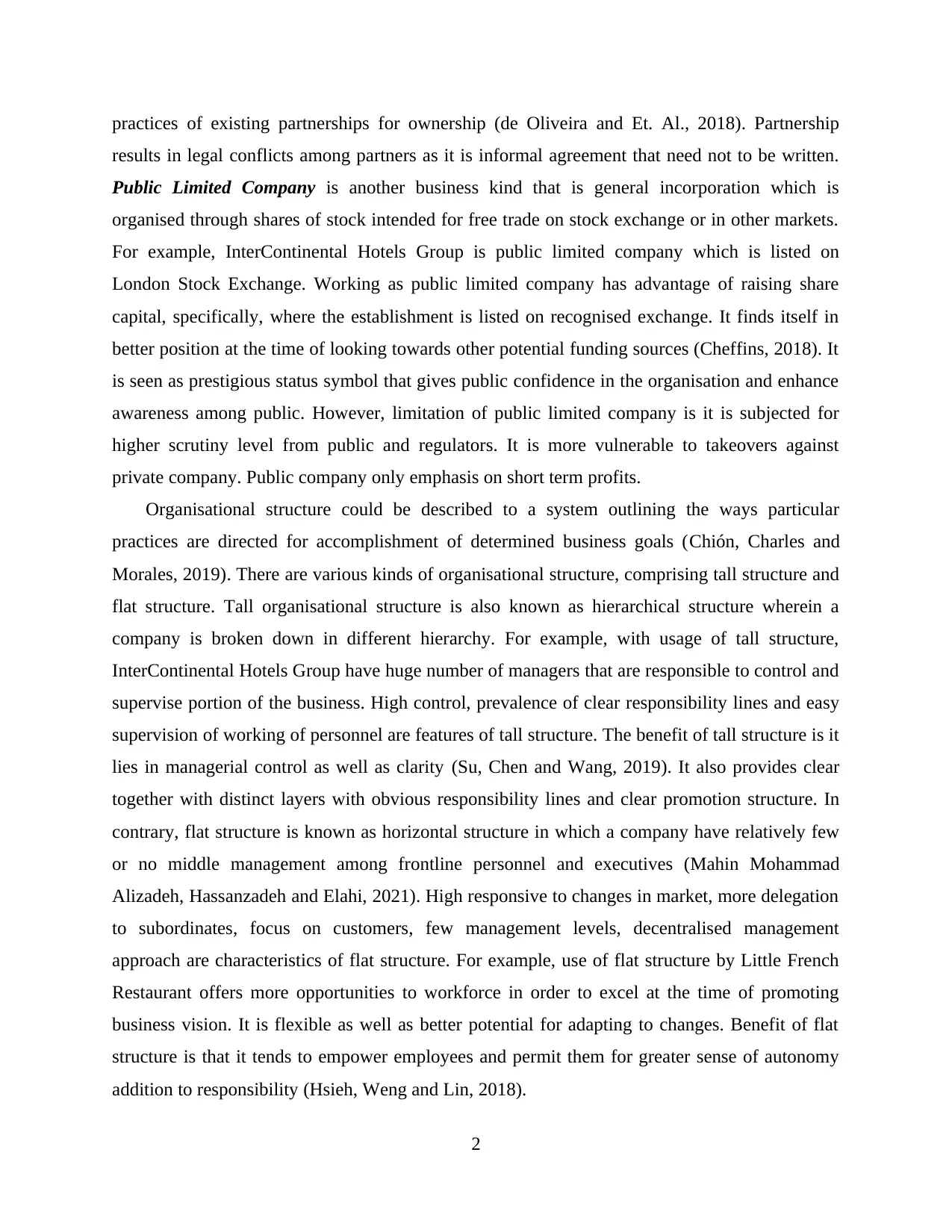
practices of existing partnerships for ownership (de Oliveira and Et. Al., 2018). Partnership
results in legal conflicts among partners as it is informal agreement that need not to be written.
Public Limited Company is another business kind that is general incorporation which is
organised through shares of stock intended for free trade on stock exchange or in other markets.
For example, InterContinental Hotels Group is public limited company which is listed on
London Stock Exchange. Working as public limited company has advantage of raising share
capital, specifically, where the establishment is listed on recognised exchange. It finds itself in
better position at the time of looking towards other potential funding sources (Cheffins, 2018). It
is seen as prestigious status symbol that gives public confidence in the organisation and enhance
awareness among public. However, limitation of public limited company is it is subjected for
higher scrutiny level from public and regulators. It is more vulnerable to takeovers against
private company. Public company only emphasis on short term profits.
Organisational structure could be described to a system outlining the ways particular
practices are directed for accomplishment of determined business goals (Chión, Charles and
Morales, 2019). There are various kinds of organisational structure, comprising tall structure and
flat structure. Tall organisational structure is also known as hierarchical structure wherein a
company is broken down in different hierarchy. For example, with usage of tall structure,
InterContinental Hotels Group have huge number of managers that are responsible to control and
supervise portion of the business. High control, prevalence of clear responsibility lines and easy
supervision of working of personnel are features of tall structure. The benefit of tall structure is it
lies in managerial control as well as clarity (Su, Chen and Wang, 2019). It also provides clear
together with distinct layers with obvious responsibility lines and clear promotion structure. In
contrary, flat structure is known as horizontal structure in which a company have relatively few
or no middle management among frontline personnel and executives (Mahin Mohammad
Alizadeh, Hassanzadeh and Elahi, 2021). High responsive to changes in market, more delegation
to subordinates, focus on customers, few management levels, decentralised management
approach are characteristics of flat structure. For example, use of flat structure by Little French
Restaurant offers more opportunities to workforce in order to excel at the time of promoting
business vision. It is flexible as well as better potential for adapting to changes. Benefit of flat
structure is that it tends to empower employees and permit them for greater sense of autonomy
addition to responsibility (Hsieh, Weng and Lin, 2018).
2
results in legal conflicts among partners as it is informal agreement that need not to be written.
Public Limited Company is another business kind that is general incorporation which is
organised through shares of stock intended for free trade on stock exchange or in other markets.
For example, InterContinental Hotels Group is public limited company which is listed on
London Stock Exchange. Working as public limited company has advantage of raising share
capital, specifically, where the establishment is listed on recognised exchange. It finds itself in
better position at the time of looking towards other potential funding sources (Cheffins, 2018). It
is seen as prestigious status symbol that gives public confidence in the organisation and enhance
awareness among public. However, limitation of public limited company is it is subjected for
higher scrutiny level from public and regulators. It is more vulnerable to takeovers against
private company. Public company only emphasis on short term profits.
Organisational structure could be described to a system outlining the ways particular
practices are directed for accomplishment of determined business goals (Chión, Charles and
Morales, 2019). There are various kinds of organisational structure, comprising tall structure and
flat structure. Tall organisational structure is also known as hierarchical structure wherein a
company is broken down in different hierarchy. For example, with usage of tall structure,
InterContinental Hotels Group have huge number of managers that are responsible to control and
supervise portion of the business. High control, prevalence of clear responsibility lines and easy
supervision of working of personnel are features of tall structure. The benefit of tall structure is it
lies in managerial control as well as clarity (Su, Chen and Wang, 2019). It also provides clear
together with distinct layers with obvious responsibility lines and clear promotion structure. In
contrary, flat structure is known as horizontal structure in which a company have relatively few
or no middle management among frontline personnel and executives (Mahin Mohammad
Alizadeh, Hassanzadeh and Elahi, 2021). High responsive to changes in market, more delegation
to subordinates, focus on customers, few management levels, decentralised management
approach are characteristics of flat structure. For example, use of flat structure by Little French
Restaurant offers more opportunities to workforce in order to excel at the time of promoting
business vision. It is flexible as well as better potential for adapting to changes. Benefit of flat
structure is that it tends to empower employees and permit them for greater sense of autonomy
addition to responsibility (Hsieh, Weng and Lin, 2018).
2
Paraphrase This Document
Need a fresh take? Get an instant paraphrase of this document with our AI Paraphraser
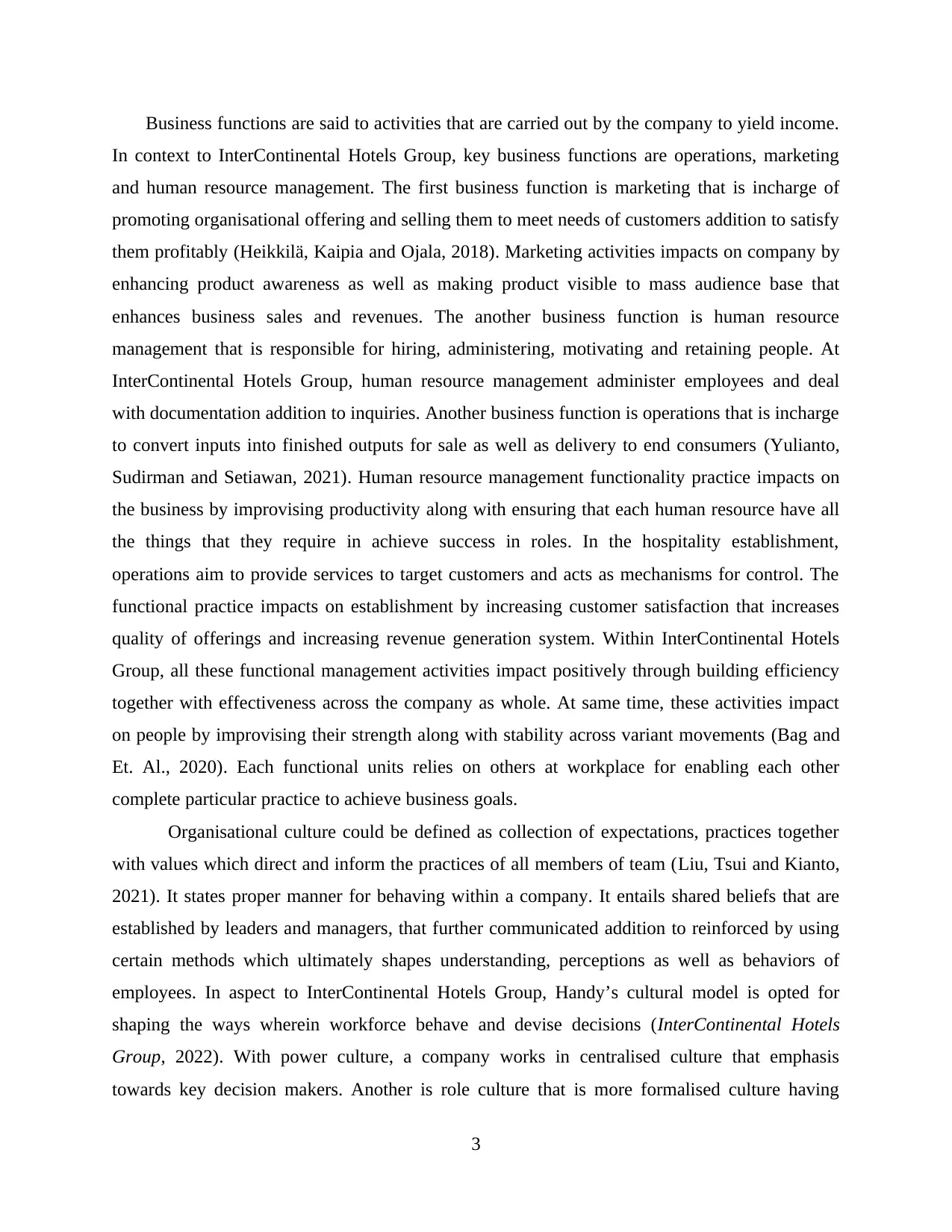
Business functions are said to activities that are carried out by the company to yield income.
In context to InterContinental Hotels Group, key business functions are operations, marketing
and human resource management. The first business function is marketing that is incharge of
promoting organisational offering and selling them to meet needs of customers addition to satisfy
them profitably (Heikkilä, Kaipia and Ojala, 2018). Marketing activities impacts on company by
enhancing product awareness as well as making product visible to mass audience base that
enhances business sales and revenues. The another business function is human resource
management that is responsible for hiring, administering, motivating and retaining people. At
InterContinental Hotels Group, human resource management administer employees and deal
with documentation addition to inquiries. Another business function is operations that is incharge
to convert inputs into finished outputs for sale as well as delivery to end consumers (Yulianto,
Sudirman and Setiawan, 2021). Human resource management functionality practice impacts on
the business by improvising productivity along with ensuring that each human resource have all
the things that they require in achieve success in roles. In the hospitality establishment,
operations aim to provide services to target customers and acts as mechanisms for control. The
functional practice impacts on establishment by increasing customer satisfaction that increases
quality of offerings and increasing revenue generation system. Within InterContinental Hotels
Group, all these functional management activities impact positively through building efficiency
together with effectiveness across the company as whole. At same time, these activities impact
on people by improvising their strength along with stability across variant movements (Bag and
Et. Al., 2020). Each functional units relies on others at workplace for enabling each other
complete particular practice to achieve business goals.
Organisational culture could be defined as collection of expectations, practices together
with values which direct and inform the practices of all members of team (Liu, Tsui and Kianto,
2021). It states proper manner for behaving within a company. It entails shared beliefs that are
established by leaders and managers, that further communicated addition to reinforced by using
certain methods which ultimately shapes understanding, perceptions as well as behaviors of
employees. In aspect to InterContinental Hotels Group, Handy’s cultural model is opted for
shaping the ways wherein workforce behave and devise decisions (InterContinental Hotels
Group, 2022). With power culture, a company works in centralised culture that emphasis
towards key decision makers. Another is role culture that is more formalised culture having
3
In context to InterContinental Hotels Group, key business functions are operations, marketing
and human resource management. The first business function is marketing that is incharge of
promoting organisational offering and selling them to meet needs of customers addition to satisfy
them profitably (Heikkilä, Kaipia and Ojala, 2018). Marketing activities impacts on company by
enhancing product awareness as well as making product visible to mass audience base that
enhances business sales and revenues. The another business function is human resource
management that is responsible for hiring, administering, motivating and retaining people. At
InterContinental Hotels Group, human resource management administer employees and deal
with documentation addition to inquiries. Another business function is operations that is incharge
to convert inputs into finished outputs for sale as well as delivery to end consumers (Yulianto,
Sudirman and Setiawan, 2021). Human resource management functionality practice impacts on
the business by improvising productivity along with ensuring that each human resource have all
the things that they require in achieve success in roles. In the hospitality establishment,
operations aim to provide services to target customers and acts as mechanisms for control. The
functional practice impacts on establishment by increasing customer satisfaction that increases
quality of offerings and increasing revenue generation system. Within InterContinental Hotels
Group, all these functional management activities impact positively through building efficiency
together with effectiveness across the company as whole. At same time, these activities impact
on people by improvising their strength along with stability across variant movements (Bag and
Et. Al., 2020). Each functional units relies on others at workplace for enabling each other
complete particular practice to achieve business goals.
Organisational culture could be defined as collection of expectations, practices together
with values which direct and inform the practices of all members of team (Liu, Tsui and Kianto,
2021). It states proper manner for behaving within a company. It entails shared beliefs that are
established by leaders and managers, that further communicated addition to reinforced by using
certain methods which ultimately shapes understanding, perceptions as well as behaviors of
employees. In aspect to InterContinental Hotels Group, Handy’s cultural model is opted for
shaping the ways wherein workforce behave and devise decisions (InterContinental Hotels
Group, 2022). With power culture, a company works in centralised culture that emphasis
towards key decision makers. Another is role culture that is more formalised culture having
3
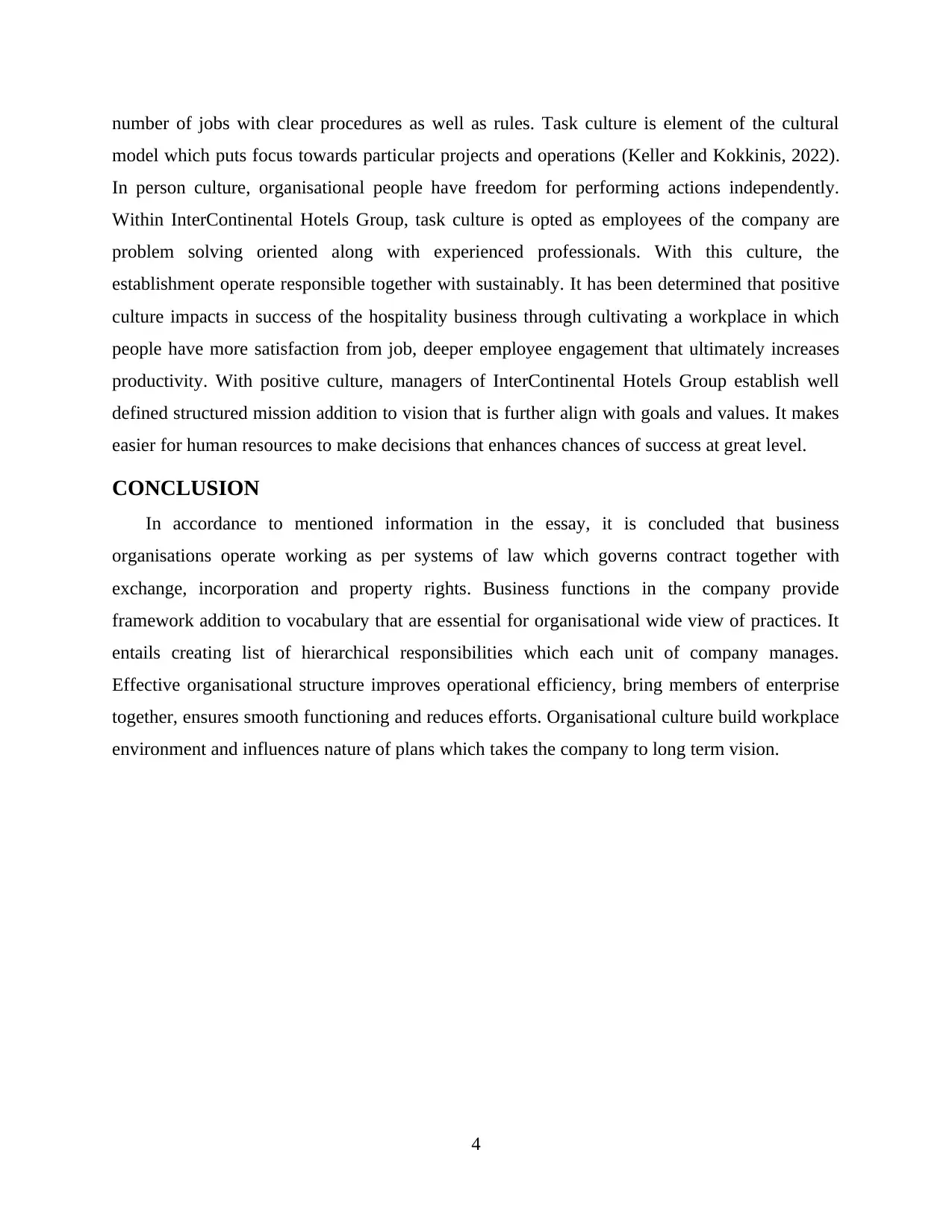
number of jobs with clear procedures as well as rules. Task culture is element of the cultural
model which puts focus towards particular projects and operations (Keller and Kokkinis, 2022).
In person culture, organisational people have freedom for performing actions independently.
Within InterContinental Hotels Group, task culture is opted as employees of the company are
problem solving oriented along with experienced professionals. With this culture, the
establishment operate responsible together with sustainably. It has been determined that positive
culture impacts in success of the hospitality business through cultivating a workplace in which
people have more satisfaction from job, deeper employee engagement that ultimately increases
productivity. With positive culture, managers of InterContinental Hotels Group establish well
defined structured mission addition to vision that is further align with goals and values. It makes
easier for human resources to make decisions that enhances chances of success at great level.
CONCLUSION
In accordance to mentioned information in the essay, it is concluded that business
organisations operate working as per systems of law which governs contract together with
exchange, incorporation and property rights. Business functions in the company provide
framework addition to vocabulary that are essential for organisational wide view of practices. It
entails creating list of hierarchical responsibilities which each unit of company manages.
Effective organisational structure improves operational efficiency, bring members of enterprise
together, ensures smooth functioning and reduces efforts. Organisational culture build workplace
environment and influences nature of plans which takes the company to long term vision.
4
model which puts focus towards particular projects and operations (Keller and Kokkinis, 2022).
In person culture, organisational people have freedom for performing actions independently.
Within InterContinental Hotels Group, task culture is opted as employees of the company are
problem solving oriented along with experienced professionals. With this culture, the
establishment operate responsible together with sustainably. It has been determined that positive
culture impacts in success of the hospitality business through cultivating a workplace in which
people have more satisfaction from job, deeper employee engagement that ultimately increases
productivity. With positive culture, managers of InterContinental Hotels Group establish well
defined structured mission addition to vision that is further align with goals and values. It makes
easier for human resources to make decisions that enhances chances of success at great level.
CONCLUSION
In accordance to mentioned information in the essay, it is concluded that business
organisations operate working as per systems of law which governs contract together with
exchange, incorporation and property rights. Business functions in the company provide
framework addition to vocabulary that are essential for organisational wide view of practices. It
entails creating list of hierarchical responsibilities which each unit of company manages.
Effective organisational structure improves operational efficiency, bring members of enterprise
together, ensures smooth functioning and reduces efforts. Organisational culture build workplace
environment and influences nature of plans which takes the company to long term vision.
4
⊘ This is a preview!⊘
Do you want full access?
Subscribe today to unlock all pages.

Trusted by 1+ million students worldwide
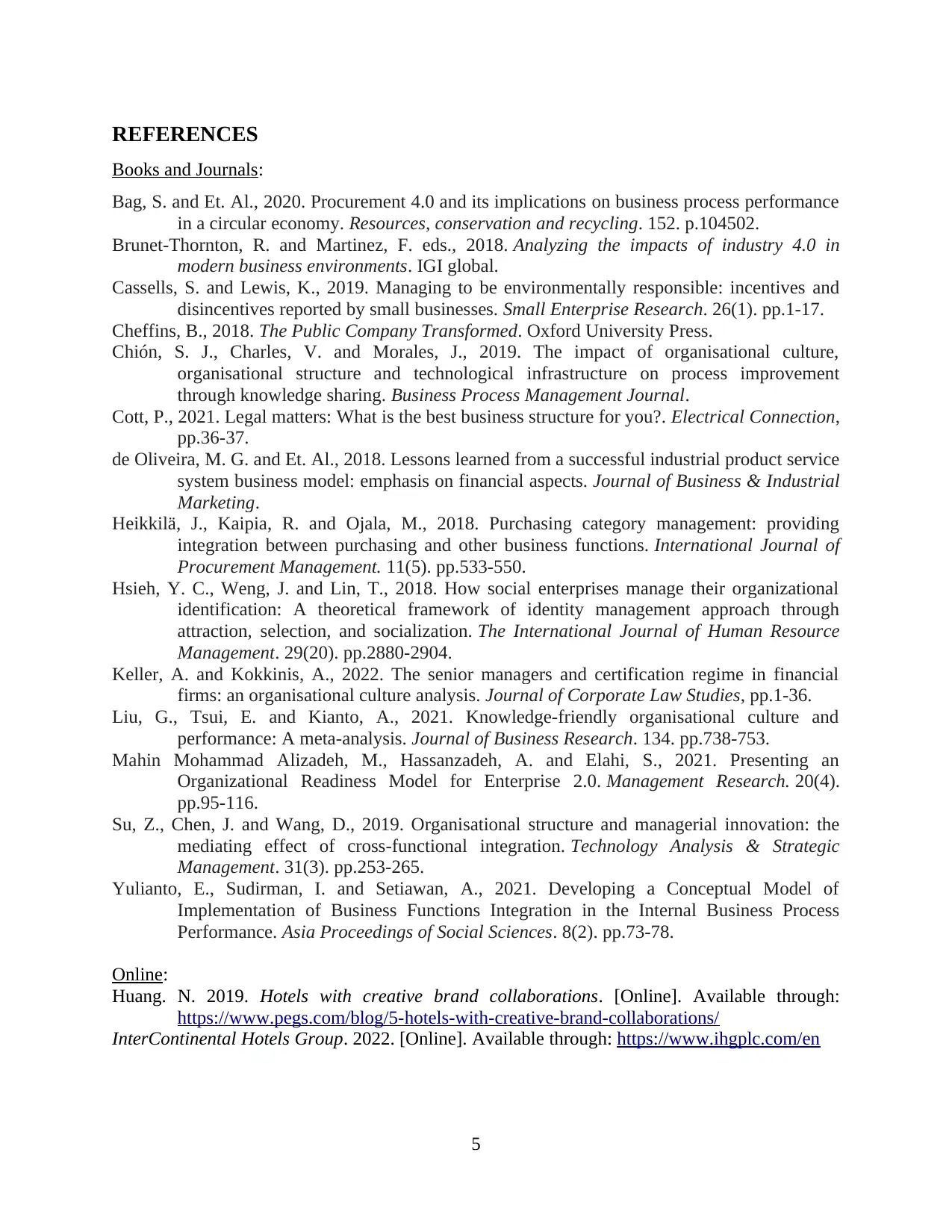
REFERENCES
Books and Journals:
Bag, S. and Et. Al., 2020. Procurement 4.0 and its implications on business process performance
in a circular economy. Resources, conservation and recycling. 152. p.104502.
Brunet-Thornton, R. and Martinez, F. eds., 2018. Analyzing the impacts of industry 4.0 in
modern business environments. IGI global.
Cassells, S. and Lewis, K., 2019. Managing to be environmentally responsible: incentives and
disincentives reported by small businesses. Small Enterprise Research. 26(1). pp.1-17.
Cheffins, B., 2018. The Public Company Transformed. Oxford University Press.
Chión, S. J., Charles, V. and Morales, J., 2019. The impact of organisational culture,
organisational structure and technological infrastructure on process improvement
through knowledge sharing. Business Process Management Journal.
Cott, P., 2021. Legal matters: What is the best business structure for you?. Electrical Connection,
pp.36-37.
de Oliveira, M. G. and Et. Al., 2018. Lessons learned from a successful industrial product service
system business model: emphasis on financial aspects. Journal of Business & Industrial
Marketing.
Heikkilä, J., Kaipia, R. and Ojala, M., 2018. Purchasing category management: providing
integration between purchasing and other business functions. International Journal of
Procurement Management. 11(5). pp.533-550.
Hsieh, Y. C., Weng, J. and Lin, T., 2018. How social enterprises manage their organizational
identification: A theoretical framework of identity management approach through
attraction, selection, and socialization. The International Journal of Human Resource
Management. 29(20). pp.2880-2904.
Keller, A. and Kokkinis, A., 2022. The senior managers and certification regime in financial
firms: an organisational culture analysis. Journal of Corporate Law Studies, pp.1-36.
Liu, G., Tsui, E. and Kianto, A., 2021. Knowledge-friendly organisational culture and
performance: A meta-analysis. Journal of Business Research. 134. pp.738-753.
Mahin Mohammad Alizadeh, M., Hassanzadeh, A. and Elahi, S., 2021. Presenting an
Organizational Readiness Model for Enterprise 2.0. Management Research. 20(4).
pp.95-116.
Su, Z., Chen, J. and Wang, D., 2019. Organisational structure and managerial innovation: the
mediating effect of cross-functional integration. Technology Analysis & Strategic
Management. 31(3). pp.253-265.
Yulianto, E., Sudirman, I. and Setiawan, A., 2021. Developing a Conceptual Model of
Implementation of Business Functions Integration in the Internal Business Process
Performance. Asia Proceedings of Social Sciences. 8(2). pp.73-78.
Online:
Huang. N. 2019. Hotels with creative brand collaborations. [Online]. Available through:
https://www.pegs.com/blog/5-hotels-with-creative-brand-collaborations/
InterContinental Hotels Group. 2022. [Online]. Available through: https://www.ihgplc.com/en
5
Books and Journals:
Bag, S. and Et. Al., 2020. Procurement 4.0 and its implications on business process performance
in a circular economy. Resources, conservation and recycling. 152. p.104502.
Brunet-Thornton, R. and Martinez, F. eds., 2018. Analyzing the impacts of industry 4.0 in
modern business environments. IGI global.
Cassells, S. and Lewis, K., 2019. Managing to be environmentally responsible: incentives and
disincentives reported by small businesses. Small Enterprise Research. 26(1). pp.1-17.
Cheffins, B., 2018. The Public Company Transformed. Oxford University Press.
Chión, S. J., Charles, V. and Morales, J., 2019. The impact of organisational culture,
organisational structure and technological infrastructure on process improvement
through knowledge sharing. Business Process Management Journal.
Cott, P., 2021. Legal matters: What is the best business structure for you?. Electrical Connection,
pp.36-37.
de Oliveira, M. G. and Et. Al., 2018. Lessons learned from a successful industrial product service
system business model: emphasis on financial aspects. Journal of Business & Industrial
Marketing.
Heikkilä, J., Kaipia, R. and Ojala, M., 2018. Purchasing category management: providing
integration between purchasing and other business functions. International Journal of
Procurement Management. 11(5). pp.533-550.
Hsieh, Y. C., Weng, J. and Lin, T., 2018. How social enterprises manage their organizational
identification: A theoretical framework of identity management approach through
attraction, selection, and socialization. The International Journal of Human Resource
Management. 29(20). pp.2880-2904.
Keller, A. and Kokkinis, A., 2022. The senior managers and certification regime in financial
firms: an organisational culture analysis. Journal of Corporate Law Studies, pp.1-36.
Liu, G., Tsui, E. and Kianto, A., 2021. Knowledge-friendly organisational culture and
performance: A meta-analysis. Journal of Business Research. 134. pp.738-753.
Mahin Mohammad Alizadeh, M., Hassanzadeh, A. and Elahi, S., 2021. Presenting an
Organizational Readiness Model for Enterprise 2.0. Management Research. 20(4).
pp.95-116.
Su, Z., Chen, J. and Wang, D., 2019. Organisational structure and managerial innovation: the
mediating effect of cross-functional integration. Technology Analysis & Strategic
Management. 31(3). pp.253-265.
Yulianto, E., Sudirman, I. and Setiawan, A., 2021. Developing a Conceptual Model of
Implementation of Business Functions Integration in the Internal Business Process
Performance. Asia Proceedings of Social Sciences. 8(2). pp.73-78.
Online:
Huang. N. 2019. Hotels with creative brand collaborations. [Online]. Available through:
https://www.pegs.com/blog/5-hotels-with-creative-brand-collaborations/
InterContinental Hotels Group. 2022. [Online]. Available through: https://www.ihgplc.com/en
5
Paraphrase This Document
Need a fresh take? Get an instant paraphrase of this document with our AI Paraphraser
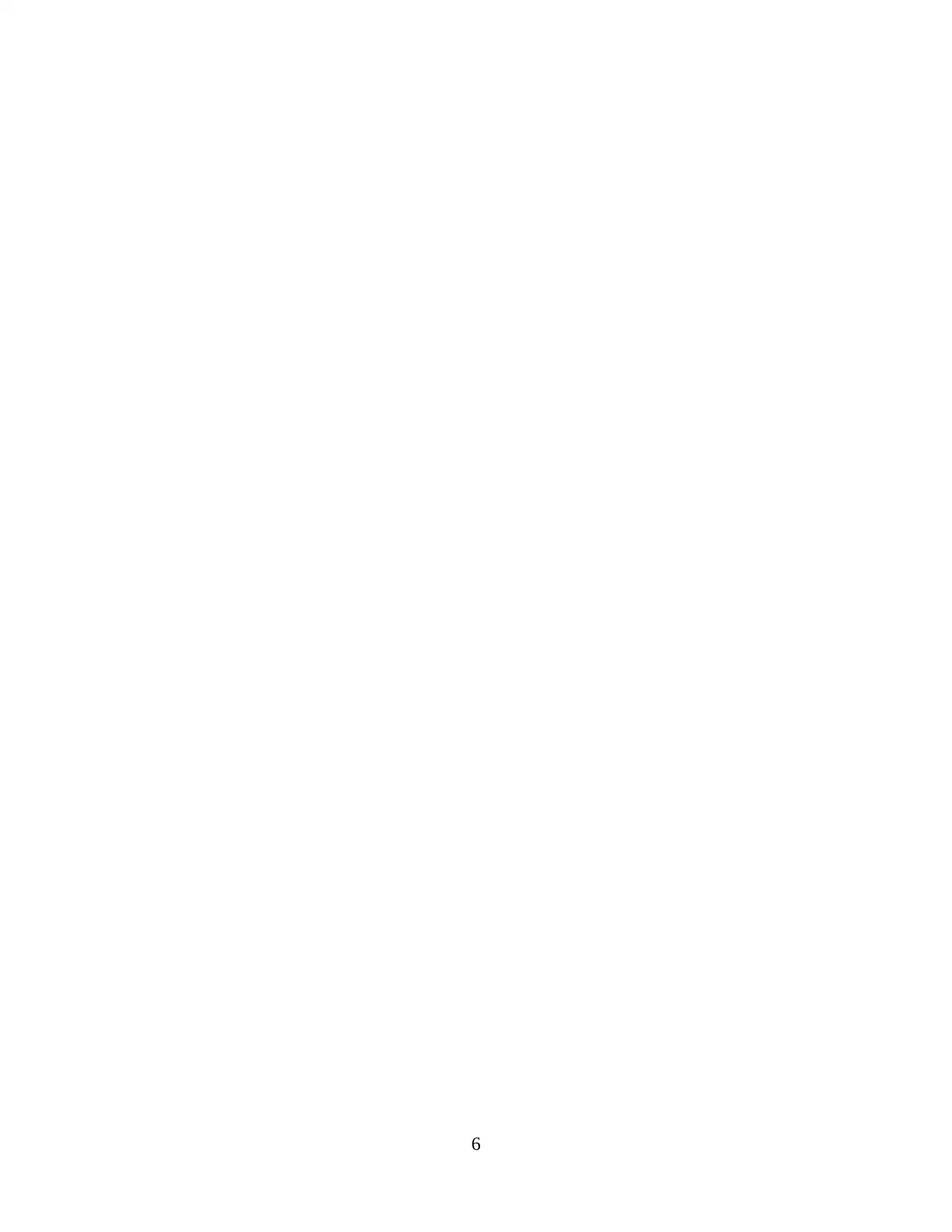
6
1 out of 8
Related Documents
Your All-in-One AI-Powered Toolkit for Academic Success.
+13062052269
info@desklib.com
Available 24*7 on WhatsApp / Email
![[object Object]](/_next/static/media/star-bottom.7253800d.svg)
Unlock your academic potential
Copyright © 2020–2025 A2Z Services. All Rights Reserved. Developed and managed by ZUCOL.


